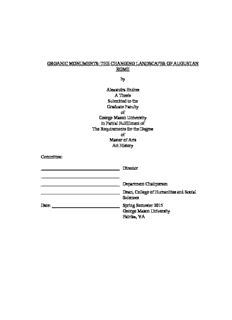
ORGANIC MONUMENTS: THE CHANGING LANDSCAPES OF AUGUSTAN ROME by Alexandra ... PDF
Preview ORGANIC MONUMENTS: THE CHANGING LANDSCAPES OF AUGUSTAN ROME by Alexandra ...
ORGANIC MONUMENTS: THE CHANGING LANDSCAPES OF AUGUSTAN ROME by Alexandra Endres A Thesis Submitted to the Graduate Faculty of George Mason University in Partial Fulfillment of The Requirements for the Degree of Master of Arts Art History Committee: Director Department Chairperson Dean, College of Humanities and Social Sciences Date: Spring Semester 2015 George Mason University Fairfax, VA Organic Monuments: The Changing Landscapes of Augustan Rome A Thesis submitted in partial fulfillment of the requirements for the degree of Master of Arts at George Mason University by Alexandra Endres Bachelor of Arts The College of William & Mary, 2012 Director: Christopher A. Gregg, Professor Department of History and Art History Spring Semester 2015 George Mason University Fairfax, VA This work is licensed under a creative commons attribution-noderivs 3.0 unported license. ii DEDICATION This thesis is dedicated to my mom and dad, who have always encouraged me to study what I love. And of course, to Moe as well. iii ACKNOWLEDGEMENTS I would like to thank my friends and family, who encouraged me throughout this entire process. I am especially indebted to my roommate Emily, who had to listen to me talk about Roman gardens from across the hall. Dr. Gregg, I would not have been able to complete this thesis without your help and guidance, for which I am incredibly grateful. And thank you Dr. DeCaroli for providing me with additional insight to improve my writing and further my research. I would also like to thank my study song “Claire de Lune,” which I will have to retire at the respectable play count of 6,072. iv TABLE OF CONTENTS Page List of Figures....................................................................................................................vi List of Abbreviations........................................................................................................vii Abstract............................................................................................................................viii Introduction..........................................................................................................................1 Chapter One.........................................................................................................................5 Chapter Two......................................................................................................................20 Chapter Three....................................................................................................................34 Conclusion.........................................................................................................................46 References..........................................................................................................................62 v LIST OF FIGURES Figure Page Figure 1 Two laurel trees, denarius of Augustus, reverse type.........................................49 Figure 2 Livia’s Garden Room ad Gallinas, detail of a spruce tree..................................50 Figure 3 Livia’s Garden Room ad Gallinas, Panel II (engraving)....................................51 Figure 4 Landscape in vertical white panel, Villa of Agrippa Postumus, Boscotrecase...52 Figure 5 View of fresco from the House of the Wounded Adonis....................................53 Figure 6 Acanthus frieze, relief from the northern side of the Ara Pacis.........................53 Figure 7 Detail of a lizard, Ara Pacis................................................................................54 Figure 8 Detail of a woman holding a sprig of laurel, Ara Pacis......................................55 Figure 9 Detail of men wearing laurel wreaths, Ara Pacis................................................56 Figure 10 Detail of children, Ara Pacis.............................................................................57 Figure 11 Romulus and Remus at the Lupercal, Ara Pacis...............................................58 Figure 12 Numa sacrificing at the altar, Ara Pacis...........................................................59 Figure 13 Pax Augusta, Ara Pacis.....................................................................................60 Figure 14 Augustan silver krater from the Hildesheim Treasure .....................................61 vi LIST OF ABBREVIATIONS American Journal of Archaeology..................................................................................AJA The American Journal of Philology................................................................................AJP The Art Bulletin..............................................................................................................ArtB Classical Journal..............................................................................................................CJ Greece and Rome...........................................................................................................GaR Journal of Garden History.............................................................................................JGH Journal of Roman Archaeology......................................................................................JRA Mélanges de L’École française de Rome, Antiquité.................................................MÉFRA A New Topographical Dictionary of Ancient Rome.................................................NTDAR Oxford Latin Dictionary................................................................................................OLD Transactions of the American Philological Association.............................................TAPA vii ABSTRACT ORGANIC MONUMENTS: THE CHANGING LANDSCAPES OF AUGUSTAN ROME Alexandra Endres, M.A. George Mason University, 2015 Thesis Director: Dr. Christopher A. Gregg This thesis explores the manner in which the shrinking landscape of an early Imperial Rome led to an increased utilization of vegetal motifs in Roman art. Beginning in the late first century BCE, Augustus attempted to emphasize the natural world within the city by introducing actual green space through gardens, groves, and parks while also associating himself with various forms of arboreal mythology. Augustus compensated for the transient nature of these public gardens and groves by providing permanent monuments upon which the imagery of a verdant, prosperous earth could flourish, instilling within the viewer a sense of wonder and appreciation for the abundance brought forth by the emperor and the beginning of a new Golden Age in Rome. INTRODUCTION This thesis explores the manner in which the shrinking landscape of an early Imperial Rome led to an increased utilization of vegetal motifs in Roman art. Beginning in the late first century BCE, Augustus attempted to emphasize the natural world by introducing actual green space through gardens, groves, and parks while also replicating the concept in a more permanent way through the design and decoration of both public monuments and private residences. Chapter 1 serves as a compilation and analysis of ancient authors and their two diametrically opposed views of green space that existed during the Late Republic and the Early Empire. The ancient authors considered include Cato, Varro, Suetonius, Plutarch, Tacitus, Horace, Cicero, Propertius, Ovid, Cassius Dio, Pliny, Vergil, and Dionysius of Halicarnassus. Plutarch’s Life of Lucullus and Tacitus’s Annals provide much of the information surrounding the luxury and desirability of the Horti Luculliani on the Pincian Hill, while additional evidence attests to the location and political significance of other prominent Roman gardens, specifically the Horti Sallustiani and the Horti Maecenatiani. Pliny’s Natural History provides a different view of garden space, emphasizing the Roman reverence for nature rather than the frivolity of its owners. The chapter ends with a reference to Seneca’s Epistles, emphasizing the manner in which Romans perceived the divine in the natural landscape. 1
Description: